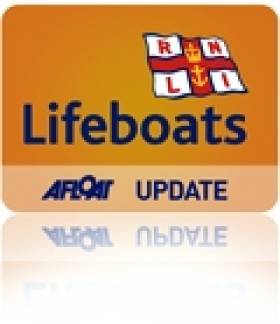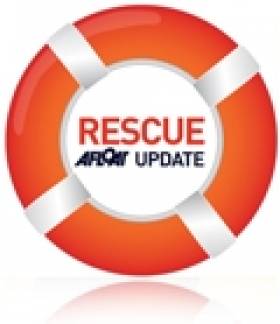Displaying items by tag: Lough Ree
Lough Ree Lifeboat Assists Seven In Two Weekend Callouts
#Lifeboats - Lough Ree RNLI assisted seven people whose vessels got into difficulty in two separate callouts over the weekend.
The volunteer crew was first requested to launch their inshore lifeboat at 6.20pm on Saturday 5 July following a report that a cruiser was experiencing engine problems off Goat Island.
- The crew responded and went to the assistance of three people on board the 30ft craft. The lifeboat towed the casualty to Ballyleague Marina, returning at 9.20pm.
The lifeboat had a second callout on Sunday 6 July at 6.57pm, this time to assist a yacht with a failed engine off the north end of Nun's Island.
The lifeboat launched at 7.08pm and towed the craft to Hodson Bay. There were two adults and two children on board.
Meanwhile, Lough Ree RNLI recently held its open day at the lifeboat station, during which it welcomed Junior Cert student Liam Chartan from Athlone Community College.
Chartan had been given a project for his exams based on a theme entitled 'My Inspiration' and chose the RNLI, and Lough Ree Lifeboat Station, in particular, as his inspiration – as he lives only a ‘shout’ away from the station and has been inspired by the crew's activities since they commenced two years ago.
Chartan designed his project around a miniature replica of the lifeboat, the Dorothy Mary, and a pedestal with the instantly recognisable RNLI motif.
"When Liam returns from his holidays we hope to have him back to the station to observe a full training exercise," said Liam Sherringham, Lough Ree RNLI volunteer lifeboat press officer.
"We hope he is surely headed for a volunteer crew role in the future, and we wish him well with his exam results."
#RNLI - Wexford RNLI came to the rescue of a woman who sustained a leg injury off the Point of Park yesterday (Friday 20 June).
The lifeboat launched at 11.44am and was on scene at 11.47am. Volunteer lifeboat crew member Matt Crispin, who is also an advanced paramedic, administered first aid on the lifeboat.
The woman was then brought to Wexford lifeboat station before being transferred to a HSE ambulance and taken to Wexford General Hospital.
- RNLI helm David Maguire commented on the skills of the volunteer lifeboat crew: "With an advanced paramedic and three advanced first aid crew on board, the woman was in safe hands."
Crew on the call-out included helm David Maguire, Matt Crispin, Frank O'Brien and Martin Conway.
Elsewhere, it was a busy Thursday evening for Lough Ree RNLI on 19 June when they received three lifeboat callouts in succession.
The first call for help was made at 4.25pm by a sailing boat standing by a cruiser on the rocks on the Long Shoal. The Lough Ree lifeboat was launched at 4.33pm and was on scene 10 minutes later.
The casualty was a 38ft cruiser with two adults and three children on board. The cruiser was refloated and checked over. There was no damage and she continued on passage with two other craft in convoy.
The volunteer crew had just finished preparing the Dorothy Mary for continued service when another call-out was received at 5.20pm by the Irish Coast Guard for a cruiser aground in Blackbrink Bay.
The lifeboat was launched at 5.23pm and was on scene at 5.39pm. This time the casualty was a 32ft cruiser with five adults on board. She was refloated and examined and was able to continue her journey.
A third and final callout was received at 7.25pm, and concerned a speedboat with two adults and three children on board that had broken down while crossing the lake from Hodson Bay.
The lifeboat was launched at 7.30pm and was on scene 15 minutes later. One adult and the three children were taken on board the Dorothy Mary, which then towed the casualty, and the remaining adult, back to Hodson Bay, departing the scene at 8.21pm.
After dropping the speedboat and her party, the lifeboat crew carried out a training exercise that had been planned for that evening, arriving back at the station at 9.20pm.
Lough Ree Lifeboat Rescues Four From Holed Cruiser
#RNLI - Lough Ree RNLI in Co Westmeath came to the aid of four people yesterday afternoon (Monday 19 May) after their cruiser got into difficulty.
The volunteer lifeboat crew was requested to launch shortly before 3.30pm following a report that a cruiser was aground on Hexagon Shoal in Lough Ree.
The boat, with two men and two women on board, was holed below waterline and was taking on water.
At the scene, the four people and their baggage were taken off the cruiser and transferred to the lifeboat by Lough Ree RNLI. They were then brought safely to the lifeboat station.
#mothtour – The Irish Moth fleet planned a weekend away in Lough Ree for our third ever event! Ronan Wallace (moth newbie) and myself (Annalise) arrived down to Quigley's Marina in Killinure early on Friday afternoon which gave us time to set up our boats before easily launching off the pontoon (staying nice and dry!) and heading out into the main lake for a great sail up and down to Hudson Bay 2 or 3 times! By the time we got in Ryan Seaton had arrived guided by his tomtom on the scenic route from Belfast to Athlone and John Chambers arrived not to soon after! Both told stories of passers by asking what kind of airplane was on the roof of their cars! We all headed to Glasson Golf Club for dinner before going back to the Killinure Chalets where we had taken up residence in the 17 man house!
The sailing weekend was organised by Cathy MacAleavey and it was for both the most modern and ancient of classes; the Moths and Water Wags! Based from Quigleys Marina in Glasson, the event included a round of golf on Friday afternoon and dinner afterwards at the Glasson Country House Hotel and Golf Club and was supported by Lough Ree YC and the National YC who each supplied support ribs.
The next morning we all got rigged and changed, then had a short briefing where Con told us the plan for the day! The idea was to do 3 races off the marina before racing downwind to The Wineport Lodge for lunch, followed by another 3 races in front of the Wineport then a race home! After one rather traumatic race where nearly everyone manage to crash into each other or the rushes at some point we headed off downwind to the Wineport which turned out to be a real adventure sailing through small cuts and around islands! Once we arrived down to the area in front of the Wineport, we did another 2 races, Rory was in good form so far winning 3 out of 3!
We then headed in to the Wineport Lodge for lunch. We were treated like kings, and had an amazing selection of soup, sandwiches, chicken wings and chips all while in our wetsuits! After possibly a sandwich or five too many we headed back out on the water, Ryan and I now regretted our decision to park our boats in the forest as getting out through the thick reeds proved to be extremely difficult, after 15 minutes of swimming while towing my boat in the extremely chilly Lough Ree water I was back on the race course, Ryan however ended up abandoning this tactic and carried his boat around to the jetty at the Wineport!
Back for more racing and it had got a bit more patchy so looking for wind was what proved to be important (and not capsizing). In race 4 Rory crashed out meters from the finish line and watched Ryan, myself and John all speed by him. Race 5 was Ryan's race finishing close to a leg ahead of the rest of us! Race 6 was a quick upwind to the windward mark then a fast reach across to the cut then a 20 tack upwind back to Quigley's Marina. Rory, Ryan and I all managed to get through the cut in the rushes foiling and we then met up with Gavin who had chosen the more sensible route home! It was then a battle of fitness and boat handling all the way back to the marina. John and Ronan unfortunately hit a lull as they raced through the cut and spent quite a bit of time stuck in the rushes.
"what kind of airplane was on the roof of the car!"
After an exhausting day 1, moth newbie Neil O'Toole had a quick blast in John's boat before we all headed to the Killinure Chalets Pub for dinner. A mix of T-bone steaks and giant crispy ducks came out so we were all very well fed at the end of a long day!
Sunday started off looking like a nice medium day but by the time we were launching it was up to 20knots gusting 25 sometimes, so Con made the call to race us just of Quigley's marina again! All 7 of us got out on the water after Gavin fixed his main foil and Neil got his boat sorted too. In some of the gusts downwind we were hitting 25-28 knots and trying to turn up at that speed is extremely difficult but luckily we had a good incentive to get the turn ups right as if we didn't we would crash into the reeds at the side of the lake! Race 7, race 8 and race 9 were won by Rory with Ryan and John taking second in one each. Ronan and me were busy trying to get around the leeward mark in both these races! In the last race of the day Rory and I were neck and neck all the way around and after an out of control round up I managed to get just ahead of him to win by a boat length!
Rory retained the teapot trophy, with Ryan in second, John and Annalise finished on equal points and then Ronan, Gavin and Neil. We all had a great weekend and would like to thank Quigley's marina for letting us launch from there, The Killinure Chalets for the great house, The Wineport Lodge for the amazing lunch and letting us sit inside their restaurant in our wetsuits! The Wag class for showing us they are definitely the class who has the most craic! But particularily to Con for being OOD and Eddie and Dara for helping out on the committee boat! Clara for the photos and not getting irate over the amount of carbon chat that happened at the weekend, and last but not least Cathy for organizing everything! It really was a brilliant weekend!
Body Found In Search For Missing NI Angler In Lough Ree
#LoughRee - A body has been found in the search for a Northern Irish angler missing for more than two weeks in Lough Ree, according to TheJournal.ie.
As reported four days ago on Afloat.ie, Daryl Burke had not been seen since the boat he was travelling in with two angling colleagues David Warnock and John Trimble overturned not far from Hodson Bay outside Athlone, Co Westmeath on the afternoon of 20 March.
Warnock and Trimble were rescued in the emergency operation that launched immediately after the incident, but Warnock died in hospital some hours later.
This week the search for Burke was concentrated on the area where the trio's boat was recovered undamaged.
And it's now being reported that a diving team from Boyne Fishermen's Rescue and Recovery Service discovered a body in a part of the lough known as The Wall yesterday afternoon (Saturday 5 April).
TheJournal.ie has more on the story HERE.
#LoughRee - Belfast's News Letter reports that the boat carrying three anglers that capsized in Lough Ree nearly two weeks ago has been recovered as the search continues for one of the party.
Daryl Burke has not been seen since the boat he was travelling in with angling colleagues David Warnock and John Trimble overturned not far from Hodson Bay outside Athlone, Co Westmeath on the afternoon of 20 March.
An eyewitness to the incident told of a "freak accident" as the three friends' boat fell victim to a sudden squall on the lough amid conditions described as "nasty" but "not particularly wild".
Warnock, 27, and Trimble, 60, were rescued from the water after an emergency operation was immediately launched. Trimble is now in recovery, but Warnock died in hospital some hours after the incident.
It's being reported that Naval Service and Garda divers are concentrating their search for Burke on the area where the boat - a 12m open-hulled vessel with an outboard motor - was recovered undamaged.
The News Letter has more on the story HERE.
Eyewitness To Lough Ree Tragedy Tells Of 'Freak Accident'
#LoughRee - The News Letter in Belfast has a report from an eyewitness to the tragedy on Lough Ree yesterday (20 March) that claimed one life today, with another man critically ill and one still missing.
Tommy Byrne told how his dogs "got a bit spooked" by the sudden squall on the lough that capsized the boat the three Co Armagh anglers were travelling in.
“It just appeared to me that the squall got them, hit their boat and sank them," he said. "It was just a random freak accident."
Byrne, who joined in with the search and rescue operation, said conditions on the lough yesterday afternoon "were nasty enough, but it wasn't particularly wild."
The News Letter has more on the story HERE.
#LoughRee - RTÉ News is reporting this morning (Friday 21 March) that one of two men recovered from Lough Ree last night has died in hospital.
The second man is still in critical condition while the search resumed this morning for a third man missing after the boat carrying the party of three capsized in strong winds near Hodson Bay outside Athlone, as reported yesterday on Afloat.ie.
It's since emerged that the three men were part of a group of six from a Co Armagh angling club.
Local anglers have joined the Lough Ree RNLI lifeboat, the Garda Water Unit and and the Athlone and Lanesborough Sub Aqua Club in the search and rescue operation, which is concentrating on a debris trail stretching some 3km along the eastern side of the lough.
Lough Ree RNLI Rescue Two Men, Search For Third Continues
#rnli – Volunteer lifeboat crew with Lough Ree RNLI were stood down at this evening (Thursday 20 March 2014) following a major search for a man believed missing when a boat carrying three men set off for Carnagh, from Hodson Bay in Athlone, earlier this afternoon. As Afloat.ie reported earlier, two men, who were on the boat were rescued by the lifeboat crew from the water and have been taken to hospital. Rescue 118 and members of the Athlone Sub Aqua Club, and Lanesborough SubAqua Club were also involved in the search for the third man.
The alarm was raised by a local man this afternoon when he witnessed the group setting off for Carnagh in a 15–foot boat. Conditions on the Lough were described as gusty with a force five to six wind. Lough Ree RNLI inshore lifeboat was launched and came upon a man in the water at 4pm. They recovered the semi-conscious casualty onto the lifeboat and transported him to Hodson Bay where he was handed over to a waiting ambulance.
The lifeboat crew immediately returned to the scene to continue the search and located a second casualty in the water at 5.15pm. He was again transferred by lifeboat back to Hodson Bay and met by ambulance.
The RNLI lifeboat crew along with the Irish Coast Guard helicopter Rescue 118 and members of the Athlone Sub Aqua club and Lanesborough Sub Aqua Club were engaged in a full scale search for a third man until they were stood down due to fading light, and the search is expected to resume at first light tomorrow.
Commenting on the search Lough Ree RNLI Lifeboat Operations Manager Damien Delaney said, "This was a major search and rescue operation on Lough Ree involving the RNLI, Coast Guard, Athlone Sub Aqua, Lanesborough Sub Aqua, and other local boats. The lifeboat crew were able to rescue two men from the water but a third remains missing.
Search For Missing Man As Two Recovered From Lough Ree
#Search - RTÉ News reports on an ongoing search and rescue operation on Lough Ree this evening (20 March) as two men have been recovered from the water as RNLI lifeboat and Air Corps teams look for a third.
It's believed that the party of three are from Northern Ireland and may have got into difficulty in their boat close to Hodson Bay, near Athlone. One of the two rescued is said to be seriously ill, and both are being treated in hospital.
More on this story as it develops.






































































